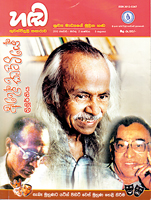Getting back to schooldays
When a newspaper editor writes a book, readers are curious to know what it’s all about. Is it fiction, is it a political commentary, is it a socio-economic study, is it an autobiography, they wonder.
The grey bearded Sunday Lakbima editor Sundara Nihathamani de Mel’s recent work ‘Mahinde Thamai Iskole’ is a mix of these – except, it is not fiction. The title itself is intriguing. Many interpret it to mean there is no school better than Mahinda! The cover has been cleverly designed to highlight the three words amidst a host of school names. Sundara, a smart columnist with his popular ‘Manige Theeruwa’ (‘Mani’ from ‘Nihathamani’), has the knack of keeping the readers guessing.
As an old boy of Mahinda – the Buddhist school dating back to the days of Colonel Olcott, Sundara has many interesting stories to relate. The reader is ‘warned’ at the outset that it is not a book meant only for Mahindians but for anyone to read and enjoy. Sundara has picked on his experiences at Mahinda and relates them in a manner which prompts the reader to go back to his own schooldays. The whole narrative revolves around people – his classmates, his contemporaries, his teachers and a few old Mahindians.
Some are well known, others not so well known. Yet the narrative makes interesting reading.Who says there was no politicking during Sundara’s school days? He relates the story of how the doyen of journalism D.B. Dhanapala, an old boy of Mahinda was invited to be chief guest at the prize giving in 1970.
Being the best orator that year, Sundara was asked to give the vote of thanks. With dreams of becoming a journalist, he was thrilled with the assignment. At the last minute it was decided to invite another old boy – politician I.A. Cader who had been elected Deputy Speaker after winning a seat at the 1970 General Election.
“However much we say politics did not affect every sphere at that time, the invitation went to Cader who was nowhere if one were to weigh him with Dhanapala. Not only was I disappointed in not being able to propose the vote of thanks to such a great personality, it was a loss to the whole school. He could not be invited again – he was no more by the time of the next prize giving.”
The book is full of anecdotes – some quite amusing. He remembers the school trips in the early days. He relates how he suffered with the breakfast. He was used to butter and jam with the bread. During the trip they were given bread and ‘seeni sambo’l – the latter with a good dose of chilli. Once while coming back from a trip to Kandy, when everyone started buying fruits on the way, he also bought a green fruit with an odd shape. He started eating it, found it very bitter and quickly threw it out of the window. He had tried to taste a raw avocado!
Sundara covers a wide spectrum in the book including sports and other extra activities. He devotes the first few pages to discuss how Ananda Samarakoon wrote the song which became the National Anthem while he was a teacher at Mahinda. It was a group of boys from Mahinda who had sung the song for the first time. In the book is a picture of a commemorative plaque at the Olcott Hall recording the fact that “during the period that Ananda Samarakoon was teaching art and music in the school (1938-42) it was in this hall that songs including ‘Pinchi suda sudu ketiya’, ‘Podimal etana’ and Sri Lanka’s National Anthem (November 1940) were sung for the first time with a group of school children”.
Talking of pictures, as an editor although Sundara may insist on the quality of photographs used in the newspaper, in the book he has taken the liberty to copy old photographs from wherever he was able to pick them and use them irrespective of sharpness and clarity. It suits his narrative.
Sundara’s effort is commendable. As he rightly says, even non-old Mahindians can enjoy it. I for one, went back to my own schooldays – the Sinhala school at Hanwella and later the Bilingual School (as the English school was called – where my father was the head master (today the heads are all principals) before coming over to Ananda. Frankly I can hardly remember the early days. Of course, Sundara is much younger.
Follow @timesonlinelk
comments powered by Disqus
























